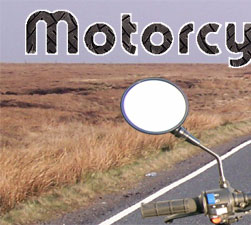|

|
By far the most critical
piece of motorcycle riding gear is the helmet. Most riders will
tell you that no matter how cautious you are, if you ride a motorcycle
you will eventually lay it down. From there is it just a matter
of how serious the motorcycle accident is and how prepared you are
for it. Wearing a proper helmet is the best thing a motorcycle rider
can do to save his or her life. National Highway Traffic Safety
Administration estimates that wearing a helmet reduces the chance
of fatal head injuries by 40% and reduces the risk of death in a
motorcycle crash by 37%.
Overall helmet design can vary but there are a few basic types to
be found in the marketplace.
- Full-Face Motorcycle Helmets: Full Face helmets cover the entire
head from the base of the skull in the rear to the chin in front.
They provide the most protection in a crash and the most protection
from the elements and general debris while riding. Most of the time
these helmets will include vents to help promote airflow and comfort
in addition to a flip up visor.
- Three-Quarter Motorcycle Helmets: Three-quarter helmets are also
known as “open face helmets.” They also protect from
the base of the skull in the rear but offer very limited front protection.
The motorcycle rider’s chin and face remain exposed at all
times. Usually additional eye protection is required in the form
of a snap on face shield, goggles or protective glasses.
- One-Half Motorcycle Helmets: One-half helmets are similar in
style to three-quarter helmets but come up higher in the rear
and offer less coverage on the sides. These helmets do not fully
protect the back of the skull and usually do not cover the ears
or jaw. These helmets leave the motorcycle rider more vulnerable
than others.
- Convertible Motorcycle Helmets: Convertible helmets are also
called “Flip up helmets.” Instead of just having a
face shield that flips up (like the full face helmet), the chin
bar and visor all lift up as one unit. This configuration allows
the rider to effectively change from full face to three-quarter
helmet on the fly. If you are interested in this style of helmet
research the models even more carefully! Some helmets have a chin
bar that flips up with the visor but does not have the structural
integrity to be considered a full face helmet when down.
A good motorcycle helmet is made up of four major components: outer
shell, impact absorbing liner, padding and a retention system. The
outer shell of a motorcycle helmet is designed to prevent penetration
and commonly composed of a tough polycarbonate or fiberglass. The
smooth curves of most helmets are also designed to cause objects
to glance off the helmet instead of penetrate. This layer absorbs
some impact through deforming but dispersing the blunt force is
mainly a job for the motorcycle helmet's impact absorbing
liner. This layer of protection is relatively thick and usually
made up of a Styrofoam material. Styrofoam may not seem rugged enough
to provide good protection but it is excellent at spreading a force
over a larger surface area and keeping it away from your skull.
The motorcycle helmet's padding is mainly for comfort while
riding and is made up of soft foam covered in fabric. In some helmets,
this lining is removable to make cleaning easier, which is good
because a funky helmet is no fun. The retention system is usually
a nylon strap that goes under the rider's chin and is secured
with a D-ring buckle or a quick release clip. They make add-ons
that will convert a buckle strap into a quick release clip if that's
your preference. The important thing is that you use whatever retention
system you have. A helmet can't protect you unless it says
on your head. One important fact to note is that a motorcycle helmet
is only designed to survive ONE impact. Like a crumple zone on a
car, the components of a helmet are destroyed in protecting your
head. Even if a helmet is dropped or falls to the ground its protective
capacity can be compromised though it may look fine. If a helmet
is dropped, many manufacturers will allow you to send it back for
evaluation to make sure it is still crash worthy. They also make
little impact gauges you can stick on a helmet to alert you if the
helmet has absorbed a potentially damaging impact. Because some
of the impact absorbing materials can deteriorate over time, it
is a smart move to replace helmets every couple years to ensure
the best protection possible.
Motorcycle Helmets - JC Whitney
The two most common certifications you will find on a motorcycle
helmet are DOT approved and Snell approved. DOT approved helmets
have met the minimum requirements set by the Department of Transportation.
These standards are fairly relaxed and do not undergo testing as
rigorous as Snell approved motorcycle helmets. The Snell Memorial
Foundation (http://www.smf.org/) was founded in 1957 and subjects
helmets to a gauntlet of tests in varying conditions before endorsing
them. These tests include: impact tests, stability tests, retention
tests, chin bar tests (full face only), penetration tests and flame
resistance tests. Motorcycle helmet manufacturers submit a number
of sample helmets to endure these torture tests but even after approval,
Snell will continue to randomly test samples they purchase from
the same sources as the public to ensure proper standards are maintained.
This foundation exists with the sole purpose of helping ensure riders
have quality helps and many riders will only select a motorcycle
helmet with their endorsement.
Learn
more about DOT,Snell & European safty standards.
Helmet laws vary by state;
some require helmets up to a certain age, some require them
for all riders, some never require them. Many areas will
require riders to have some kind of shatter resistant eye
covering (often satisfied by sunglasses). Such laws often
dumbfound non-riders since they assume sunglasses are being
used as a safety alternative to helmets. While helmets play
a critical role in helping riders survive crashes, they
don’t do much to prevent the crash in the first place.
On the other hand, imagine how difficult it would be to
control a motorcycle after being hit in the eye by a bug
or pebble at highway speeds. At 60 miles even stones or
insects can feel like BBs. There is value in laws that require
proper eye protection but the best scenario is to protect
both your eyes and the rest of your head at the same time
with a good full-face helmet.
Learn
more about motorcycle helmet laws in each state.
|






